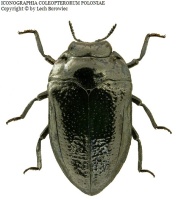Підтримуємо Вільну Україну
 We Support Free Ukraine
We Support Free Ukraine

Biodiversity Map
Taxa

Habroloma — subordinate taxa:
Taxon count: 2
-
Arthropodaphylum
Click to switch
to select orders
and filters > -
Hexapodasubphylum
Click to switch
to select orders
and filters > -
Insectaclass
Click to switch
to select orders
and filters > -
Coleopteraorder
Click to set
as the main taxon
and as a base
← of the left panel > -
Polyphagasuborder
Click to set
as the main taxon
and as a base
← of the left panel > -
Elateriformiaseries
Click to set
as the main taxon
and as a base
← of the left panel > -
Buprestoideasuperfamily
Click to set
as the main taxon
and as a base
← of the left panel > -
Buprestidaefamily
Click to set
as the main taxon
and as a base
← of the left panel > -
Agrilinaesubfamily
Click to set
as the main taxon
and as a base
← of the left panel > -
Trachysinitribe
Click to set
as the main taxon
and as a base
← of the left panel > -
Trachysinasubtribe
Click to set
as the main taxon
and as a base
← of the left panel > -
Habrolomagenus
Click to set
as the main taxon
and as a base
← of the left panel > -
Habrolomasubgenus
Click to set
as the main taxon
and as a base
← of the left panel >
PL
YES
name status: valid name
BioMap ID: 1014478
taxon code: 2737
taxonomy checked: YES
Data on distribution in Poland

Statistics
- Records: 155
- Publications: 28
- Collections: 11
- Publication authors: 23
- Illustrations (iconography): 1
- Photos (specimen/observation): lacking
Taxon description
Gatunek szeroko rozprzestrzeniony w południowej, środkowej i północnej części Europy, w Finlandii docierający do koła podbiegunowego, notowany też z Kaukazu i Syberii. W Polsce wykazywany głównie na podstawie znalezisk sprzed przeszło stu lat i dlatego dane te wymagają potwierdzenia nowymi materiałami. W bieżącym wieku odkryty stosunkowo niedawno na siedliskach kserotermicznycli w okolicy Krakowa i na Wyżynie Miechowskiej. Monofag — larwy minują liście bodziszka czerwonego — Geranium sanguineum L. Miny zarysowują się bardzo charakterystycznie czarnym deseniem. Postacie dojrzałe przezimowują w ściółce koło rośliny żywicielskiej, ukazują się na wiosnę i przeżywają do lipca. Samice składają na liściach jaja, na każdym liściu tylko po jednym, pokrywając je substancją kitową.
Illustrations
... browse
 Habroloma
Habrolomananum
External data sources
- Ostatnie rekordy
-
1061435
 ×
× Buprestidae: Habroloma nanum, CZ, Hinanice, 1999, leg. Z. Kraus
Buprestidae: Habroloma nanum, CZ, Hinanice, 1999, leg. Z. Kraus -
1010863
 ×
× Buprestidae: Habroloma nanum, Dźwinogród, 1937, coll. MiIZ PAN: Tenenbaum Sz.
Buprestidae: Habroloma nanum, Dźwinogród, 1937, coll. MiIZ PAN: Tenenbaum Sz. -
1010862
 ×
× Buprestidae: Habroloma nanum, Dźwinogród, 1937, coll. MiIZ PAN: Tenenbaum Sz.
Buprestidae: Habroloma nanum, Dźwinogród, 1937, coll. MiIZ PAN: Tenenbaum Sz. -
1010861
 ×
× Buprestidae: Habroloma nanum, Dźwinogród, 1937, coll. MiIZ PAN: Tenenbaum Sz.
Buprestidae: Habroloma nanum, Dźwinogród, 1937, coll. MiIZ PAN: Tenenbaum Sz. -
1010860
 ×
× Buprestidae: Habroloma nanum, Dźwinogród, 1937, coll. MiIZ PAN: Tenenbaum Sz.
Buprestidae: Habroloma nanum, Dźwinogród, 1937, coll. MiIZ PAN: Tenenbaum Sz. -
1010859
 ×
× Buprestidae: Habroloma nanum, Dźwinogród, 1937, coll. MiIZ PAN: Tenenbaum Sz.
Buprestidae: Habroloma nanum, Dźwinogród, 1937, coll. MiIZ PAN: Tenenbaum Sz. -
1010858
 ×
× Buprestidae: Habroloma nanum, Dźwinogród, 1936, coll. MiIZ PAN: Tenenbaum Sz.
Buprestidae: Habroloma nanum, Dźwinogród, 1936, coll. MiIZ PAN: Tenenbaum Sz. -
1010857
 ×
× Buprestidae: Habroloma nanum, Dźwinogród, 1936, coll. MiIZ PAN: Tenenbaum Sz.
Buprestidae: Habroloma nanum, Dźwinogród, 1936, coll. MiIZ PAN: Tenenbaum Sz. -
1010856
 ×
× Buprestidae: Habroloma nanum, Dźwinogród, 1936, coll. MiIZ PAN: Tenenbaum Sz.
Buprestidae: Habroloma nanum, Dźwinogród, 1936, coll. MiIZ PAN: Tenenbaum Sz. -
1010855
 ×
× Buprestidae: Habroloma nanum, Dźwinogród, 1936, coll. MiIZ PAN: Tenenbaum Sz.
Buprestidae: Habroloma nanum, Dźwinogród, 1936, coll. MiIZ PAN: Tenenbaum Sz. - ... more
- Powiązane publikacje
-
Gutowski J.M., Ługowoj J. 2000. Buprestidae (Coleoptera) of the Białowieża Primeval Forest. Pol. Pismo Ent., 69:279-318.
 Show records
Show records -
Bidas M. 1997a. Bogatkowate (Coleoptera: Buprestidae) nowe dla Gór Świętokrzyskich. Wiad. Entomol., 16(2):120 [188].
 full text
full text Show records
Show records -
Burakowski B., Mroczkowski M., Stefańska J. 1985. Chrząszcze – Coleoptera. Buprestoidea, Elateroidea i Cantharoidea. Katalog Fauny Polski, XXIII, 10, Warszawa.
 Show records
Show records -
Szymczakowski W. 1973. Dalsze materiały do znajomości chrząszczy (Coleoptera) biotopów kserotermicznych Polski. Acta Zool. Cracov., 18:183-216.
 Show records
Show records -
Szymczakowski W. 1965. Materiały do poznania chrząszczy (Coleoptera) siedlisk kserotermicznych Polski. Pol. Pismo Ent., 35:225-257.
 Show records
Show records - ... more





